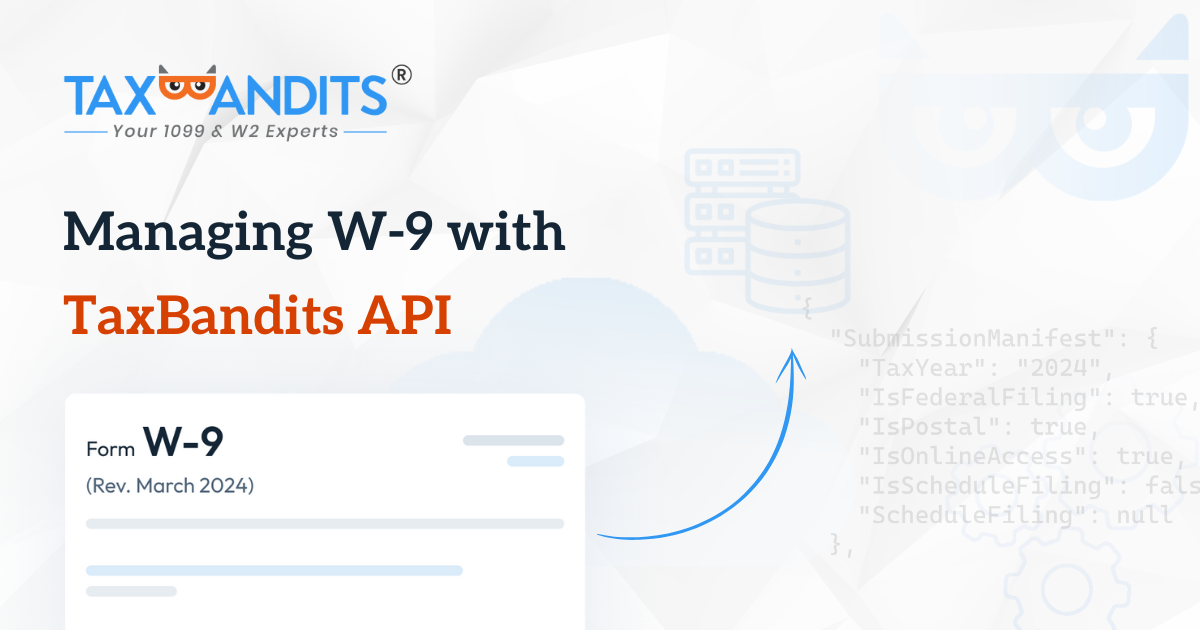The W-9 form plays a crucial role in tax compliance for many businesses. While it’s not directly filed with the IRS or SSA, collecting this form from the appropriate individuals or entities is essential for accurate 1099 filings.

TaxBandits API provides a comprehensive solution for businesses of all sizes to streamline and automate the W-9 collection process. Our API offers a variety of flexible options to meet the unique needs of different business use cases. Understanding which solution fits your business is key to maximizing efficiency.
In this blog, we’ll explore some common use cases for businesses managing W-9 forms and how TaxBandits API can help you address each one seamlessly.
Use Case 1: Your Business is the Sole Payer
This scenario applies when your business directly pays contractors or vendors for their services. You will be the only payer centralizing payments and tax compliance for all recipients.
How to Manage W-9 Forms in this Scenario
-
Create a Default Business Profile:
-
Set up a default business account using your company’s name to manage W-9 collection and storage centrally.
ExampleIf your company, “ABC Tech Solutions,” hires freelance developers, graphic designers, and consultants, you can organize all their W-9s under the “ABC Tech Solutions” business profile.*
-
-
Methods to Request W-9 Forms:
-
RequestByEmail: Send a direct email request to contractors/vendors, prompting them to complete and submit their W-9 forms through a secure link.
ExampleYou email a freelance developer, John Michael, to fill out his W-9 via a secure link.*
-
RequestByUrl: Generate a unique, secure URL for each recipient. You can share this URL via email or embed it in your internal platform or vendor portal.
ExamplePost the unique URL on your company’s vendor onboarding portal, where each contractor can log in and complete their W-9.*
-
DropIn UI: Integrate a branded, user-friendly W-9 collection interface directly into your website or internal systems to automate and simplify the process.
ExampleImplement the Drop-in UI on your vendor registration page, ensuring seamless data collection.*
-
-
Handling Bulk Requests:
-
If you prefer to use a common W-9 collection URL instead of a unique URL for each recipient, you can use the RequestByBusinessUrl method. This method generates a single URL for all recipients and is particularly useful when managing high volumes of contractors.
ExampleA construction company can use a single link for its subcontractors to fill out W-9 forms, streamlining operations.
-
-
Storage and Retrieval:
- Once the forms are submitted, they are securely stored under your business name, ensuring easy access and compliance.
Use Case 2: Your Business Has Subsidiaries as Payers
This scenario applies if your business oversees subsidiaries that directly employ and pay contractors or vendors. Each subsidiary functions as an independent payer while the parent company ensures compliance.
How to Manage W-9 Forms for Subsidiaries
-
Option 1: W-9 Management Under Parent Business
- Create a default business using the parent company’s name to manage all W-9 forms centrally.
Example
“ABC Global Services Inc.” collects all W-9 forms for vendors working across its subsidiaries, such as “ABC Solutions” and “ABC Corp.”*
- Use the RequestByEmail, RequestByUrl, RequestForBusiness, or Drop-in UI methods to collect forms from contractors, storing them directly under the parent business.
- Create a default business using the parent company’s name to manage all W-9 forms centrally.
-
Option 2: W-9 Management Under Subsidiaries
- Create separate businesses for each subsidiary and designate them as the “Requestor” in your W-9 request.
- Use the RequestByEmail, RequestByUrl, or DropIn UI methods for each subsidiary to collect W-9 forms.
Example
Each subsidiary – “ABC Solutions” and “ABC Corp” has its own W-9 collection portal, ensuring contractors’ forms are stored under the respective subsidiary’s profile.*
Special Cases: Vendors Working for Multiple Subsidiaries
-
If a contractor works with multiple subsidiaries, request their W-9 only once and link the form to the respective subsidiaries using the LinkWhCertificate method.
ExampleSarah, a freelance graphic designer, works with both “ABC Solutions” and “ABC Corp.” Her W-9 form is collected once and linked to both subsidiaries for compliance.*
The Bottom Line
TaxBandits API provides you with not just an automated solution but flexible options to manage your W-9 forms that align with your use case. Leverage our API and take your W-9 management to the next level.
